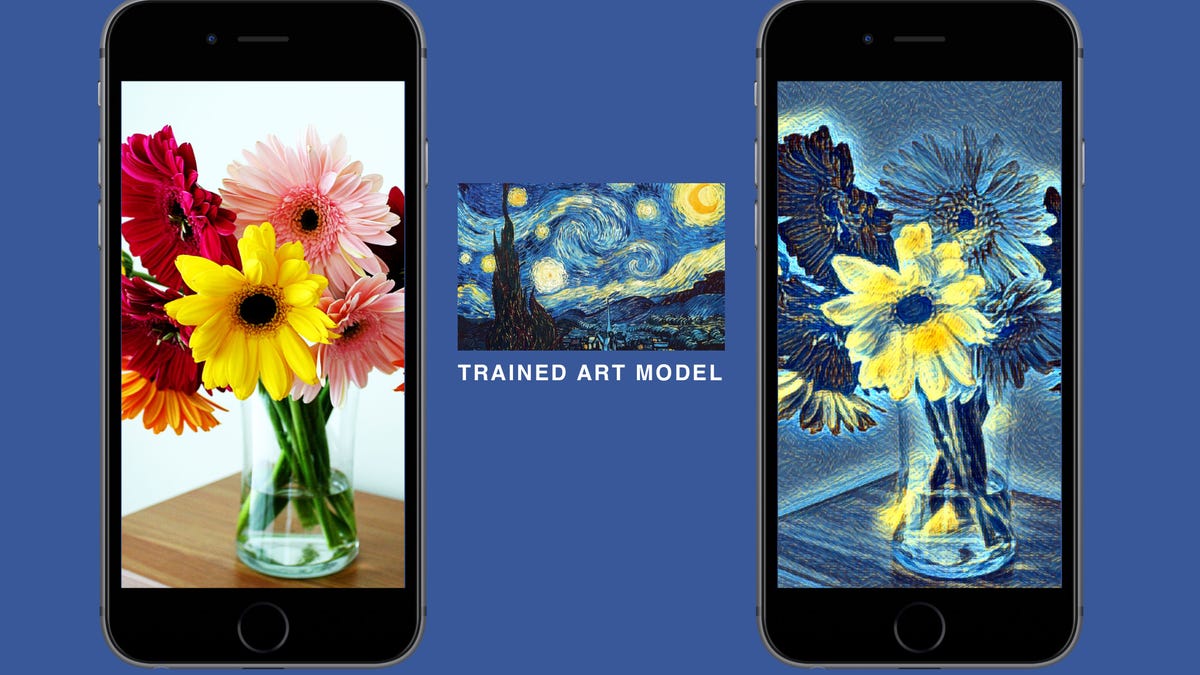Facebook: Get some Van Gogh into your video
AI tech will let Facebook's Android and iOS apps apply artistic styles to users' videos. Also coming: Everyday VR and 4 billion more people on the net.
Worried the video you're sharing is a little blah? Facebook will let you tap into the creative juices of Pablo Picasso or Vincent Van Gogh with a coming update to its mobile app.
With artificial intelligence technology called Caffe2Go built into its Android and iOS apps, the top social network will add a feature that adapts your video as you watch to incorporate the style of those painters or a handful of others. Chief Technology Officer Mike Schroepfer announced the move at the Web Summit conference in Lisbon, Portugal, on Tuesday. You'll be able to pick an artist style from some preset options.
Your kid's birthday party won't be shown in the Metropolitan Museum of Art, but it might stand out better in your friends' news feeds.
The feature embodies the breakneck pace of progress in the field of artificial intelligence, and in particular an approach called neural networks that are inspired by human brains. AI software that could bring a painter's style to photos emerged in a 2015 academic paper, then surged in popularity this year with the Prisma app. The feature initially relied on central servers to do the heavy computational work, but Prisma will now run on phone processors, and it's getting video support.
Facebook engineers took interest in June, and now they're just about ready to launch the feature, Schroepfer said in a meeting with reporters. "This is a pretty big leap in power. This is a real neural net running on my phone in real time."
Some of the Facebook style transfer options.
Google researchers also are trying to speed up style transfer with AI. Like Facebook, Google is an AI superpower that's already using the futuristic technology for real-world tasks.
Facebook has high hopes for AI, tapping it today to generate photo captions for visually impaired users of its social network. But the company isn't worried about a robot takeover yet. "The problem is these systems are incredibly easy to fool," Schroepfer said, showing a photo of an airplane disastrously clipping a bridge midcrash. The caption generator identified it merely as an airplane on the tarmac.
Also cooking: internet access and VR
Internet access and virtual reality are the other two major elements of Facebook's 10-year tech plan, Schroepfer said.
Facebook uses computer processing to figure out where Terragraph radio stations can provide direct line-of-sight links to wireless broadband customers.
To bring faster internet access to the world, including the 4 billion or so people who aren't using it today, Facebook has a three-tier access plan.
- Terragraph uses short-range wireless links to connect urban homes and businesses to the network with speeds of a gigabit per second -- a rate well over 10 times what the average broadband customer in the US gets today.
- For suburban areas, 1,000-pound pilotless planes called Aquila will soar high overhead for months at a time, at twice or three times the elevation of conventional jets, beaming data down and connecting to the internet with high-speed laser links.
- For rural areas, satellite communications will hook people up. Facebook's ambition in this area was hampered when a SpaceX rocket exploded, destroying the communications satellite Facebook had planned to lease to connect people in sub-Saharan Africa.
"It's sort of a bummer," Schroepfer said. "It set back launch capacity for the entire industry, and it's going to set back our programs in Africa. But that's why we do multiple things at once."
Virtual reality
With its Oculus Rift headset, Facebook has one of the highest-profile virtual reality efforts in the industry. It's expensive and requires an even more expensive PC to provide the necessary computing and graphics horsepower -- the kind of thing that's a good match for gaming enthusiasts.
But in the long run, ordinary folks will appreciate VR, too, Schroepfer said.
"This is really the end goal: Think about Facebook not as a website or a mobile app, but as the current best technology for helping you keep in touch with your friends and family," he said.
Today, Facebook Messenger has video and voice calling, but, Schroepfer said, "I think VR is going to be the best form of that. If you want to catch up with your mom or dad, who may be far away, VR is the most promising technology to do that."


